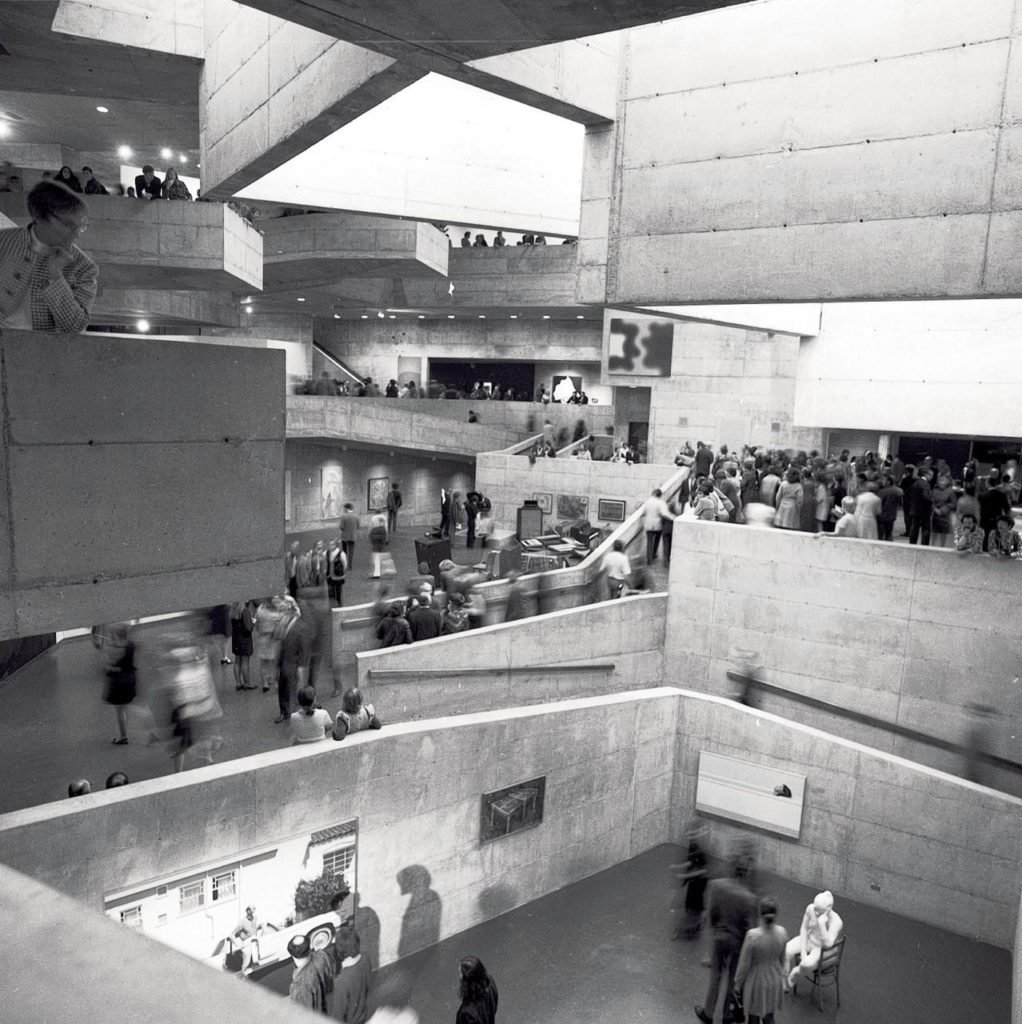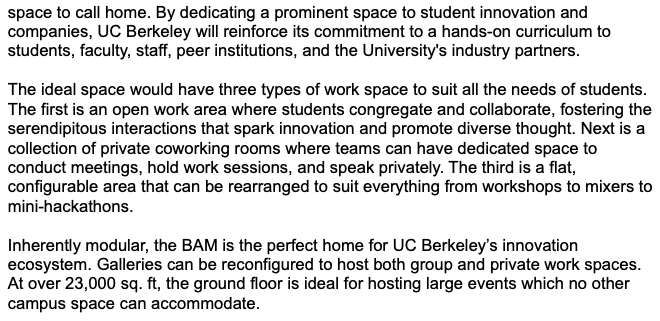Origins: Bakar BioEnginuity Hub
The November 5, 1970, opening of the Berkeley Art Museum. Photo: Greg Peterson, SF Chronicle.
The Baker BioEnginuity Hub (BBH) officially opened yesterday, marking the beginning of a new chapter for Life Science entrepreneurship at UC Berkeley.
This is happening on the heels of Jennifer Doudna’s Nobel Prize-winning recognition for her world-changing CRISPR gene editing research, which has already sparked incredible Berkeley startups such as Caribou, Mammoth, and Scribe.
Congrats and thanks to the visionaries who spent a good part of a decade bringing this space to life — Barbara Bass Bakar, Amy Herr, and Reg Kelly. There are also many others who helped make BBH possible.
A little-known tale is the impact a small, wide-eyed band of students had almost seven years ago…
Slide Cameron Baradar & I presented to Barbara Bakar in 2015 at her office.
My story with this building dates back to my time as an undergrad on campus, when I used to wander around the Berkeley Art Museum (BAM), crush homework at their cafe, Babette, and even once, attended a legendary concert in the museum headlined by the band Animal Super Species.
In 2014, I was actively working with a group of students on creating a big enough community space for student entrepreneurs to learn and build. For reference, we started with turning closet-sized spaces on campus into innovation spaces. The demand and use were high enough such that those spaces started to smell.
One day, I was in Babette guzzling coffee, when I caught wind that the art museum was moving — BAM would be the dream space.
Cameron Baradar & I in the new BBH space last night at the grand opening.
In early 2015, when I committed to dedicating my life to Berkeley entrepreneurship, I organized a group of student leaders on campus at my apartment on Warring Street for a secret, weekly salon to determine what the future at Berkeley e-ship should look like. We couldn’t get the art museum out of our heads, so we crafted a thoughtful one-page proposal for campus administrators.
Around the same time, these administrators and faculty would congregate for a monthly meeting in the Vice Chancellor for Research’s office at California Hall. As representatives of the students’ voice, fellow student leader Alex Kern and I shared our proposal in that forum, which was welcomed by the group.
When Cathy Koshland, at the time Vice Provost for Academic Planning and Facilities (now Provost) was accepting proposals for the use of BAM, we students turned this one-pager into an eight-page proposal and submitted it. We collaborated with University leaders at IPIRA, who also submitted a proposal to turn the art museum into an innovation space, sparking a powerful bottoms up & top down case.
Excerpt from our 8-page proposal to turn BAM into an innovation & startup space. See below for more excerpts.
The innovation space concept was selected! But there was a catch…
UC Berkeley needed to raise at least $30M (!!!) to seismically retrofit the building.
Not long after, I went full-time on bringing what would become The House Fund to life, while my partner Cameron started building The House Foundation. And we still couldn’t get BAM out of our heads. Here’s where it gets fun…
When we started raising capital for our space concept, we met legendary CEO, executive, and philanthropist Barbara Bass Bakar in her office in SF. We were the first to pitch her on the idea of funding this space for entrepreneurship (slide from that pitch included above).
Ultimately, our efforts took us in a different direction, opening up a small (relative to the 57K sqft BAM) and scrappy space just down the street about a year later. More on that in future Origins posts.
In her talk last night at the event, Doudna mentioned how she celebrates and elevates her students’ spirits saying,
“Students will have an idea, and they are not afraid of doing something crazy.” She pushes her students to ask, “how do we make sure that the work we’re doing does have broad impact?”.
Nobel Prize winner Jennifer Doudna at the event, with one of her big fans.
Why share these Origins? To achieve our shared goal of building the top university startup ecosystem and scaling Berkeley’s impact on our planet, it takes an incredible amount of time and dedication from committed leaders like Barbara, Amy, and Reg. It has been almost seven years since my initial meeting with Barbara. During that time period, these leaders worked tirelessly year over year and executed on an audacious endeavor.
I couldn’t be more excited to see Bakar BioEnginuity Hub come to life. The right answer was always to turn this space into a hub for entrepreneurship and innovation. Today, that is pointed toward solving hard scientific problems that can change the world for the better.
If BBH leaders follow Doudna’s breakthrough example, as well as her leadership in enabling young innovators that will be the next great CEOs (like Rachel Haurwitz, Trevor Martin, and Ben Oakes), that impact will almost certainly happen.
I look forward to working with and supporting the next generation of life science entrepreneurs at Berkeley. BHH is an important, bold initiative that is going to take Berkeley’s vibrant, growing startup ecosystem to the next level.
-Fiance
Website: Bakar BioEnginuity Hub
This is the first post of Origins — a series of blog posts on the history of entrepreneurship at UC Berkeley.
Shout out to the former student leaders now alums who worked on this proposal, many of whom have gone on to start up: Cameron Baradar, Sam Kirschner, Alex Kern, Shanthi Shanmugam, Rick Ling, Taner Dagdelen, Milad Razavi, and Steven Buccini.
Here is some history of this Berkeley Art Museum building, now BHH.
See below for a longer exerpt of our University proposal for the use of BAM below.







